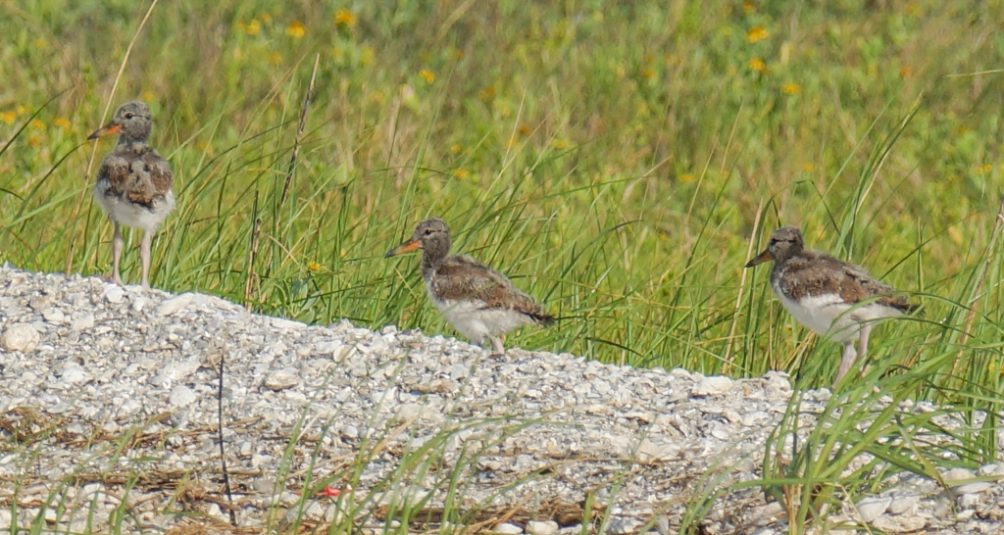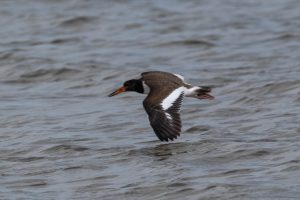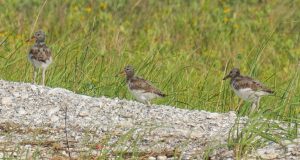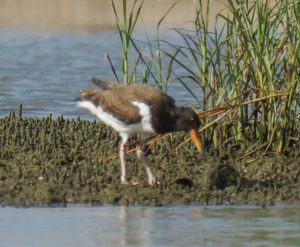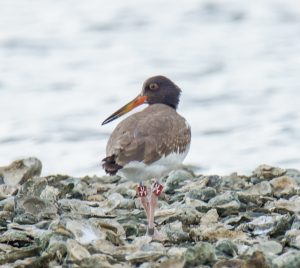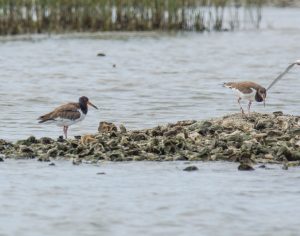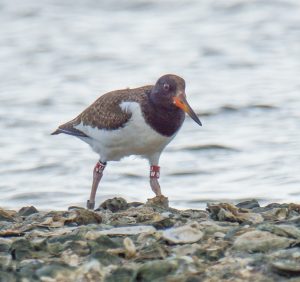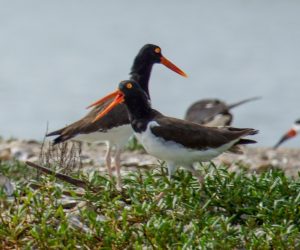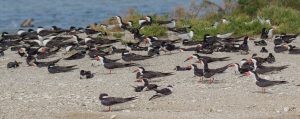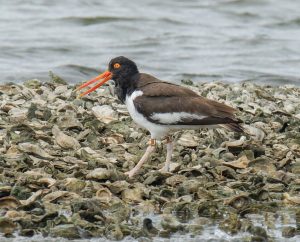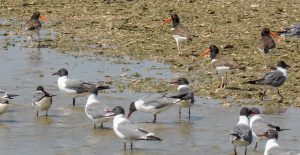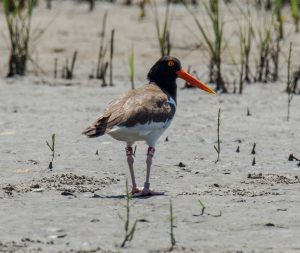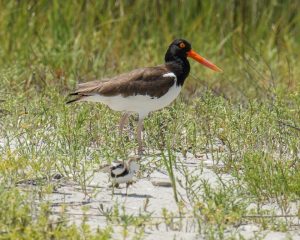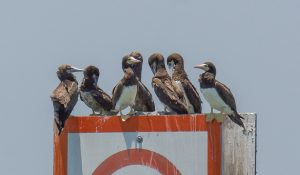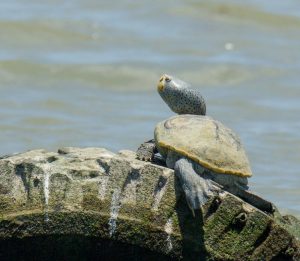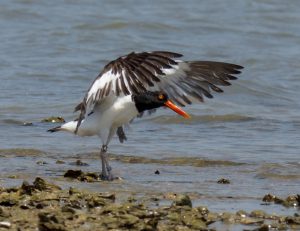By Susan Heath
It’s been a while since we chatted about oystercatchers and I’m happy to be back! As Nora O’Donnell says on the CBS evening news – there’s a lot of news to get to tonight! This week we visited all our field sites to see what’s been happening. On Tuesday I went to East Matagorda Bay with GCBO Coastal Biologist Taylor Bennett, GCBO intern Morgan Barnes, and Amanda Hackney from Blackcat GIS. It’s colonial waterbird survey time so Amanda came along to help us count. We found A7A & unbanded on their nesting island with a scrape but no eggs. They had an earlier nest that failed so hopefully they are ready to try again. Farther down the GIWW we checked on ER & unbanded and their chick W5W. They were all there and when we approached W5W showed off by flying! Woohoo! It’s always nice to see them fly for the first time.
At Old Gulf Cut we counted the nesting Black Skimmers, Forster’s Terns, and Gull-billed Terns and then checked on 25 & unbanded and their chicks U9X and U8Y. Similar to W5W, U9X showed off its newly acquired flight skills but U8Y ran instead of flying when we approached. I guess it isn’t fledged yet. It’s been nearly 60 days since these chicks hatched and the usual fledging time is 35 days so it’s taking quite a while for this one to fledge. I’m sure it will be flying soon though. Sometimes it takes longer when there is more than one chick because the adults have to provide more food and U9X has just attained flight so U8Y can’t be far behind! We continued on our route but the other nests had all failed so we headed back to the boat ramp.
On Wednesday I toured West Galveston Bay with Master Naturalist Alan Wilde. Amanda came along again to help with the waterbird counts along the Galveston shoreline. We headed up to Swan Lake first and for once it wasn’t very windy so the ride across the bay didn’t jar our teeth loose. 20 & unbanded’s nest had failed for unknown reasons but we got a nice surprise when we checked on LR & unbanded. We thought they only had one chick but surprise! There are actually three.
I’m not exactly sure when that nest hatched since our visits have been sporadic but I think they are between 15 and 20 days old. In Swan Lake proper we confirmed that only one of K7 & unbanded’s chicks fledged. They had two earlier but only one now.
There aren’t any other nests up there but we discovered 11 & unbanded hanging out on a shelly bank in an area we haven’t seen them before. Maybe there’s a nest in their future!
Back down in West Galveston Bay, we went to the miracle that is Struve Luci Island. I call it a miracle because here’s what’s happened. 12 & unbanded fledged three chicks and so did LT & JA! Many years we don’t have even one pair that fledges three chicks so to have two of them on the same island is incredible! Here’s one of 12 & unbanded’s chicks and two of LT & JA’s chicks.
Then there’s HM & X7 who successfully fledged two chicks from a rock wall that juts out from Galveston Island. If you know coyotes (and raccoons and feral cats) like I do, you will be amazed that they didn’t find this nest or the chicks for the approximately 70 days from egg laying to chick fledging.
And finally there’s the tale of KR & unbanded. We never knew they had a nest but suddenly they had two very large chicks! On the same day we discovered the chicks, Alan’s photos revealed that KR had fishing line badly entangled on both feet. Oh no! I came prepared to try to catch her this week with the net gun but sadly she had disappeared and been replaced by an unbanded bird. I hope that bird will help KR’s mate feed the chicks even though they aren’t hers so they don’t die. It appeared that’s what was happening, but we’ll know more next week.
Oystercatchers can be very altruistic! But also, it’s hard to get a territory so I guess feeding someone else’s chicks is worth it if you get to move in. The fifth pair on that island (L9 & unbanded) have had two nests and at least one hatched two chicks but they didn’t make it. They are in the heart of the skimmer colony and I guess it’s hard to survive with all those birds around.
On Jigsaw, LH & T6’s nest had hatched and we saw one of them up in the vegetation. Fingers crossed it was protecting some chicks. YE & unbanded were still incubating their two egg nest so we left them to it. We found 16 alone on the Galveston shoreline where he nested every year until this one.
This year he nested on South Deer island after all the other pairs abandoned the area. He and his mate had two chicks which disappeared when they were about two weeks old. Then he was ousted from this new territory by Y7 & unbanded who moved in after they were ousted from their territory next door by A5A & unbanded. Having trouble keeping up? I’m not surprised! But there’s more! When we arrived to check on A5A & unbanded, we found four oystercatchers. Three unbanded ones plus A5A.
What’s up with that? South Deer has been a bit of an enigma this year. All the pairs from previous years abandoned and a few new pairs moved in but none have been successful. Besides the previous story of pair shuffling, F1A & E2A, a new pair this year finally laid a nest with one egg. A meager effort! Maybe they will lay more.
The two pairs on Gangs Bayou haven’t had any success this year either and an entire Caspian Tern colony on that island was wiped out by what we think was Crested Caracara predation. All the eggs were broken open and most of the insides eaten out. I suspect the caracaras might be the cause of all the problems on South Deer too.
We headed down the Galveston Island shoreline to see what colonial waterbird colonies were active so we could count them. We haven’t been down there at all this year so I wasn’t sure what to expect. We found only a few skimmers in Carancahua Bay and two pairs of oystercatchers but no nests or chicks. I was happy to see C9A. We haven’t seen it since we banded it last year.
The other pair are both unbanded and they seemed unfazed by this male Wilson’s Plover who was going absolutely beserk at their presence. I went up and looked around and didn’t find a nest or chicks so I don’t know what the plover’s issue was but he was very happy when I ran the oystercatchers off!
The only other nesters we were found were some terns on Bay Harbor. Not much to write home about but we counted them all and then headed back up the bay and went across to check on the Brown Boobies on the shell marker signs. There have been three pretty consistently for the last 3-4 months so imagine our surprise when we saw this.
Seven of them! Where are they all coming from? At this rate we will be monitoring Brown Booby nests soon (and I wouldn’t mind a bit!). After we got over our shock we went back to oystercatchers. YM & JH and E6A & unbanded had both increased their egg count to two on North Deer, but C1A & unbanded had failed again (third time!). Those dang pelicans won’t give the oystercatchers a break. Alan snapped an excellent photo of a Diamond-backed Terrapin on an old tire out in the bay. I guess those tires are good for something after all.
On Marker 52, it was time for JJ & P4’s nest to hatch but they were not there so I guess the chicks didn’t make it. The pelicans are a problem there too! W5 & JC surprised us with a new nest with one egg. I think this might their third try as well.
I think FR is still mad at me for accidentally catching him twice and then having the gall to band his first offspring ever. I haven’t seen him, his wife, or his chicks since they fledged but they’ve been home when Alan has been out kayaking. Happy travels FR! I’m happy for you even if you don’t appreciate my enthusiasm for your efforts.
In Jones Bay, CA & Y2 were still incubating three eggs. High hopes for them! X4 & unbanded have yet to produce a nest but X4 was doing its best Black Heron imitation.
Don’t know what a Black Heron is? Check it out!
So that’s the story in West Galveston Bay. Without all those fledged chicks on Struve Luci and FR’s fine efforts, it would be a sad story this year but it’s not over yet!
On Thursday, Taylor, Morgan, and I went to Drum Bay to check on JK & unbanded’s chick (otherwise known as the little swimmer). We found the whole family happily hanging out on their island so I guess all is well there. Most of the other pairs out there have either failed or haven’t even tried. We discovered a new colonization in Bastrop Bay though. J8, a male I banded in this area way back in 2012, suddenly appeared with an unbanded mate on a small island that no one has tried to nest on since 2014. We’ll see how that goes.
Hopefully we’ll be able to continue the blog until the season ends. Stay safe everyone!
If you like oystercatchers and you want to support this project, you can make a donation (thank you!) on our website here. And how could anyone not like oystercatchers!
Current Stats for upper Texas coast from Dickinson Bay to East Matagorda Bay: 7 nests being incubated, 33 failed nests, 2 nests with unfledged chicks, 0 nests with undetermined status, 15 chicks fledged
Note: All trapping and banding for this project is in accordance with federal and state permits issued to Susan Heath, GCBO Director of Conservation Research. Bird handling by volunteers is only permitted in the presence of Susan Heath and volunteers are trained in proper bird handling techniques.

